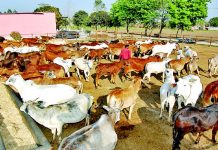This article has been written by Manya Dudeja, from the University School of Law and Legal Studies, Guru Gobind Singh Indraprastha University. The article tries to explore a rather ignored and taken-for-granted branch of legal rights i.e. the fundamental rights of animals.
Table of Contents
Introduction
Mahatma Gandhi once said, “the greatness of a nation can be judged by the way its animals are treated”.
Human beings have adamantly always considered themselves the “better” or the more “advanced” species of all. They have given to themselves a State or governing authority and for most, a constitution as well. While democratic societies ensure fundamental rights to their citizens, more civilised and sensitive ones grant fundamental rights to their animals too.
In the Indian context, various Constitutional provisions are safeguarding and protecting the rights of animals, yet, their implementation and adequacy has been questioned time and again. It is this laxity that makes it important that a topic as critical to life and as humane as this, be brought to the table and a conversation be triggered to provide a voice to the voiceless beings keeping the ecosystem alive.
Fundamental rights refer to those rights that have received the recognition to require a higher degree of protection from encroachment. They form the basic tenets of existence. Here, the recognition of guaranteed fundamental rights has been extended to apply to animals as well.
Do animals possess fundamental rights
The Constitution of India acknowledges the sanctity of the lives of animals and also prescribes the protection and treatment of animals with dignity. It has been provided as the fundamental duty of the citizens of the country. The Indian courts as well, through various important pronouncements have recognised the fundamental rights of animals.
The Constitutional scheme of animal rights in India
Under the framework of the Indian Constitution, the following provisions provide for the protection of animal rights in India:
- Fundamental Rights (Part III) (Article 12-Article 35);
- Directive Principles of State Policy (Part IV);
- Fundamental Duties (Part IV-A);
- The Seventh Schedule of the Constitution involves the allocation of powers between the Centre and the State;
- The Court’s Judicial Authority under Article 141 and Article 144.
Fundamental rights of animals in India
Fundamental rights, generally refer to universally acknowledged and constitutionally guaranteed rights of citizens. They play an important role not just in the development, but also in the existence of individuals in society. These rights are considered so sacrosanct that their breach is dealt with severely and can be directly pleaded in the Supreme Court, under Article 32 of the Constitution of India.
Relevant to the welfare of animals is Article 21 which is the Right to life. According to this article, the Right to life and personal liberty of a person is secured and no person shall be deprived of it, except by procedure established by law.
However, the Supreme Court has gone ahead and expanded the scope of this article for animal rights and brought them under the ambit of this article.
Animal Welfare Board of India v. A. Nagaraja and Ors.
- Facts of the case: This is with reference to a traditional sport that is practised in the Indian State of Tamil Nadu. It is called Jallikattu. Here, a bull is released in a crowd of people and the people are then supposed to grab on the bull’s hump that is on its back and hang off it while the bull would try to escape. Not only has this traditional sport caused a number of deaths of human beings, but it has also led to serious animal welfare concerns. The bulls are tortured before they are released, they are poked with sharp sticks or scythes. Their tails are brutally bent to extreme ends in order to fracture their vertebrae and they are even bitten. Some reports point out that the bulls are even forced to consume alcohol and in order to disorient them and aggravate them, the chilly powder is rubbed in their eyes. In the course of the event, knives and sticks are used to stab the bulls, they are also punched, jumped upon and dragged to the ground. In case, the bulls are not enforced, they are prone to run into ongoing traffic which can result in them breaking their bones or even dying.
The Animal Welfare Board of India (AWBI) in the year 2010, filed a case in the Supreme Court of India against this traditional sport, Jallikattu and pleaded for it to be banned. This was done on the grounds of animal cruelty and public safety. The Ministry of Environment and Forests in the year 2011, banned the use of bulls as performing animals. But, sadly, the practice continued under certain provisions of the Tamil Nadu Regulation of Jallikattu Act.
This particular case was an appeal filed by the AWBI in response to the High Court decision which allowed this traditional practice to continue under the aegis of the Tamil Nadu Act. The AWBI pleaded that the government’s notification which banned the use and performance of bulls for exhibition or training purposes be enforced.
- Supreme Court’s verdict: The Court ruled in favour of the Animal Welfare Board of India and directed that the government’s ban on Jallikattu be enforced. The court also held that Article 51A(g) is the “Magna Carta of animal rights”. It also made a number of observations regarding Article 21 including the right to life of animals.
The right to life of animals
Upholding the rights of animals under Article 21, the Supreme Court said that subject to the law of the land, all and every species own the right to life and security. This also includes depriving it of its life. Article 21 not only safeguards the rights of human beings but also protects “life”. Here, the scope of the word, “life” has been expanded to include any disturbance from the basic environment as well. The basic environment would include every form of life including animals as they are inherent for the existence of human life as well and falls within the purview of this article. Life holds meaning much broader than just mere survival, it includes a life with worth, honour and dignity.
The legal capacity of animals to possess rights
In the above case, the court gave non-human animals constitutional rights. According to Joseph Raz, “rights cannot be accorded to animals as they only have an instrumental value and do not have any interests or the kind of mental development as humans do”. In his view, they exist in the ecosystem only to be used by humans for their needs and benefits. However, this can be refuted as animals do show interest in protecting their basic welfare needs such as food and sleep. And hence this theory of denying non-human animals their rights cannot stand.
According to Bentham, the criteria to decide rights to a living being should be to address the question of whether they undergo suffering. It is the ability to feel pain and suffering which forms in his view, the basis to be included in the purview of rights. This has been understood to be flawed as suffering cannot be the only criteria to accord rights. The nature of rights have to be understood and the common characteristics between humans and non-human animals have to be in conformity with the rights humans have in society.
Court on its own motion v. And Another, 2018
In this case, by using an instant letter petition, a resident of Shimla, drove the court’s attention towards the state of ponies located at the Ridge, Shimla. The question before the court was whether domesticated horses that are licenced for use in joy rides for children on the Ridge, (Shimla) have a right to shelter during extreme weather conditions, For example, rain or snow.
The petitioner pleaded that the horses should be protected and safeguarded. If this was not done, the Ridge would lose its plight as the people would be able to see through the treatment meted out to the ponies. These animals are used as a source for recreation. However, the owners of the animals do not understand their plight and merely cover them with a plastic sheet in situations of bad weather.
The High Court passed a ruling in favour of these animals and gave directions to their owners to provide worth, dignity and honour to these animals. The court also stated that in their view, animals do possess a fundamental right and it was the duty of human beings to make life easier for animals by reducing their suffering and taking care of them. It also said that there is no presence of any conflict between humans and animals. The owners and stakeholders were asked to ensure that no cruelty was directed towards the ponies. The court further stated that the behaviour of the owners is against public morale and that animals have emotions too which they express through various ways of communicating. The Deputy Commissioner, Municipal Corporation of the State was ordered by the court to take adequate action in this regard.
Other provisions safeguarding animal rights
Directive Principles of State Policy
Article 48
Under this Article, the State has to regulate agriculture and animal husbandry in accordance with modern and scientific developments. It also aims at protecting and improving the breeds and specifically, prohibits the slaughter of cows, calves, milch and draught animals.
The Constituent Assembly debated about including Article 48 in the Fundamental Rights section. However, it later settled to include it in the DPSP so that non-Hindus are not forced to accept it. The assembly also said that Fundamental Rights are limited to human beings.
Article 48A
Here, the State has to work in the direction to protect the environments and to safeguard forests and wildlife. It can be enforced under the ambit of Article 21.
Fundamental Duties
Article 51A under the fundamental duties deals with the provisions related to human rights. It was added in the Constitution adhering to the 42nd Amendment in the year 1976 in accordance with Article 29(1) of the Universal Declaration of Human Rights.
Article 51A allocates the duties to the citizens of India to protect and improve the natural environment which would include wildlife. It also asks citizens to have compassion for living creatures.
The journey of animal rights in India
Prevention of Cruelty to Animals Act, 1960 (PCA)
I
Animal Welfare Board established in 1962
I
The rising prominence of animal welfare organisations and the development of various laws and policies
I
This relates to the treatment of performing animals
They refer to animals used for entertainment for the public and by the sale of tickets
I
The Ministry of Health and Family Welfare, the Government of India banned animal testing of cosmetics
I
Intervention by the Judiciary
N.R. Nair v. Union of India
The Kerala High Court, in this case, shattered the walls between humans and non-humans and considered granting fundamental rights to animals as well and highlighted that legal rights should be extended beyond people and should not remain in the exclusive domain of human beings.
Animal Welfare Board of India v. A. Nagaraja
The Supreme Court upheld the view of granting fundamental rights of animals.
Conclusion
“Each and every animal of the earth has much right to be here, as you and me.”
– Anthony Douglas Williams
The very fact that animals have a right to not just exist, but to live with dignity, derives for them the fundamental right to life. These rights mustn’t just sit on paper but should be guaranteed to them and in cases of infringement, remedies should be provided. Here, it is the stakeholders, as well as conscientious citizens of the country, who have to take it upon themselves to uphold the rights and dignity of their fellow living beings. The court has backed the fundamental rights of animals through its pronouncements. Constitutional provisions, though available, are not adequate and efficient enough and a lot still needs to be done to ensure a dignified life for animals.
References
- https://www.deccanherald.com/opinion/panorama/the-mind-is-what-we-make-of-it-960882.html
- http://www.legalserviceindia.com/legal/article-1203-rights-of-animals-under-the-indian-legal-system-justifiable-amendable-curative-reformative.html
LawSikho has created a telegram group for exchanging legal knowledge, referrals and various opportunities. You can click on this link and join:
 Serato DJ Crack 2025Serato DJ PRO Crack
Serato DJ Crack 2025Serato DJ PRO Crack











 Allow notifications
Allow notifications



